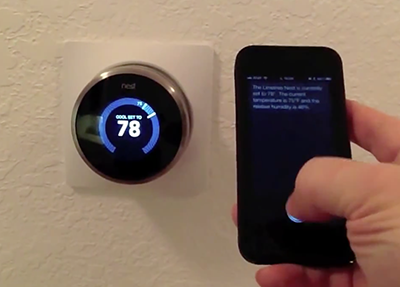
ReadWriteHome is an ongoing series exploring the implications of living in connected homes.
Nothing influences people’s comfort or mood like a warm, toasty environment or a cool, invigorating climate. And yet, of all the technologies in the home, the lowly thermostat gets the least respect— even though nobody likes costly energy bills each month.
Ex-Apple staffers Tony Fadell and Matt Rogers set about changing the perception of the thermostat with Nest. By applying their experiences from having worked on the iconic iPod, Fadell and Rogers elevated the unappealing home electronic to create the Nest “learning thermostat,” a sleek wall-mounted device designed to make home energy control and automation sexy.
This is how a product in a decidedly pragmatic (read: unexciting) category attracted a following. Since its 2011 launch, the rather elegant Nest has received loads of interest—and not just from consumers hoping to cut down on their energy bills, boost efficiency or show off a hot new technology. Smart home companies like Revolv and Control4 work with Nest, and tinkerers can’t seem to keep their hands off it.
The ideas vary from simple smartwatch apps to imaginative rewirings or software hacks to extend Nest’s control and features. But still, it’s surprising what you can do with the Nest thermostat when you apply a little elbow grease.
Nesting Tricks
Right out of the box, you can manage the connected Nest thermostat via your smartphone or the company’s website, and its automations improve over time as the device learns your habits and preferences. Those smarts allow it to track energy usage, and enable it to work as a standalone product or within a smart home system.
Still, it hasn’t been all smooth sailing for Nest. The device baffled some users with reboot and battery problems last winter, prompting the company to issue a software update. And though Nest Labs celebrated its $3.2 billion Google acquisition earlier this year, the ink was barely dry before the company once again found itself dealing with more problems last month—this time over the Nest Protect smoke and carbon monoxide detector.
Some users flew the coop, but hardly en masse. The thermostat still boasts a strong showing on Amazon, where it currently reigns as the No. 1 best seller in programmable thermostats. And at press time, its positive user feedback outnumbered the negative by far, with five-star reviews more than tripling the one-star reviews. The product may find more fans still, having launched recently to a new UK market.
Nest may not be the only smart thermostat—Ecobee to Honeywell have a few offerings as well—but its $250 device is clearly an object of fascination for consumers and hackers alike. The latter have yielded some interesting results, with creative twists that make usage more convenient, smarter—and even fun.
A few things you can do with a Nest:
Control your heating and cooling from your wrist: This is one of my favorites, and it happens to be the easiest because it involves no actual hacking on the user’s part, like the others below. It requires the Pebble smartwatch and a Pebble app called Leaf, which allows users to adjust temperatures with a few button presses on the watch. No phone, or getting up from the couch, is required.
Monitor temperatures in another room: Is your thermostat located in a room with wildly fluctuating temperatures, compared to the rest of the house? Well, with a BeagleBone Black compact Linux computer (similar to a Raspberry Pi, but usually about $20 more expensive), a few components and some open-source code, you can set your Nest to track the temperature in another room.
Get SMS notifications: Take the hack above and add Twilio’s cloud communication service and your extra-smart thermostat setup can text you with status updates.

Voice control via Siri: Will Apple debut Siri for the home like it did for the car? We don’t have the answer, but in the meantime, crafty hackers have figured out how to use iOS’s voice feature to control and automate their homes. YouTube user Elvis Impersonator relied on open-source software SiriProxy, courtesy of Chili Technologies, plus a Raspberry Pi, a camera, controllers and a few other hardware products and parts to cobble together his own smart home system—including a nifty tidbit that controls the Nest via speech.
Voice control via Android: Now that Nest is owned by Google, Android voice command should be a no-brainer. And until official support comes out, at least there’s this: A hack by Svbtle user Norman A that uses Tasker (an automation tool) with AutoVoice (Tasker plugin) and SL4A- Python (an Android scripting layer). Stir thoroughly and voilà—voice control. The commands go through Google Now to the Nest app, which sets actions based on your spoken words.
A Nest-controlled pellet stove: Perhaps it’s a yearning for yesteryear, but heating stoves have been making a comeback recently. A popular type are pellet stoves, which forego kindling and logs for smaller ignitable bits that are fit for a fire. One man, K Lars Lohn, shared his impressive hardware hack: He managed to trick the Nest into thinking his stove was a furnace, thanks to some knowledge of wiring and heating systems.
Stay Tuned For More
Hacking won’t be the only creative outlet for the Nest thermostat. Last fall, Nest Labs announceda developer program for the device, which will officially open this year. When that launches, developers will have the tools to work out compatibility and interactions with even more connected appliances. And Nest would be able to do a variety of things, like tell an air conditioner to kick on when it’s hot outside or a clothes dryer to hold off until later, when peak energy pricing comes down.
People often think about thermostats only when they’re needed—or when they wish those clunky wall boxes would just disappear into the background entirely. But with such clear and compelling benefits, the Nest thermostat could finally step into the spotlight and emerge as the true power player in the home that it truly is.










